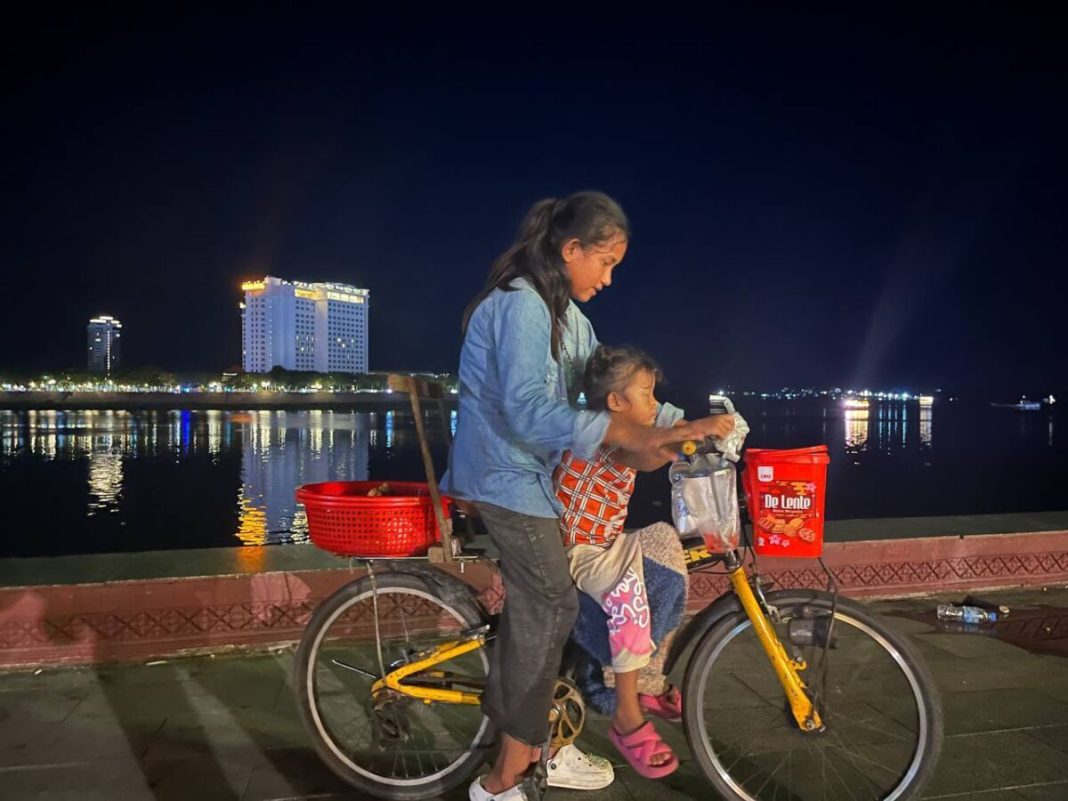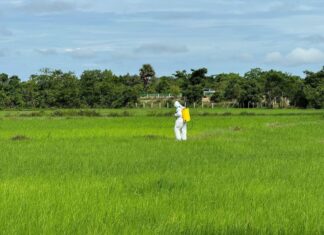Fears are growing that a generation of impoverished Cambodian children are being left behind in the government’s drive to modernize the Kingdom’s economy.
In recent years, Cambodia has pumped billions into infrastructure and development projects in an effort to graduate from “least developed country” status. Less has been spent on education, healthcare or safety net programs, and experts say little progress has been made in eliminating the worst forms of child labor, a scourge that has persisted for decades.
Despite remarkable economic achievements — the Kingdom is on track to exit LDC status in 2029 — a yawning gap between the rich and poor remains, with the young and urban poor shouldering much of the burden.
Along Phnom Penh’s popular riverfront, where the Tonle Sap joins the Mekong River, the site of underage snack sellers is common.
Theara, a weary-faced 13-year-old, began selling peanuts six years ago to help support her family.
“I’ve been selling since I was 7 years old because my mother is sick and cannot earn an income,” she said. “My mother is bedridden. My father used to work as a motorbike taxi driver, but now he is also sick, so I am the only one earning money.”
Her 3-year-old sister often accompanies her, and the two cycle the capital’s busy waterfront district until late evening. When peanut sales run slow, Theara supplements her income with commissions paid by tourist boat operators.
“When I call a Cambodian customer, the boat owner gives me 1,000 riels,” she said. “If it’s a foreign customer, I get 8,000 riels. I have to call for the boats sometimes because there are days when I don’t have money to buy peanuts, so I just call for customers.”
Theara dreams of becoming a doctor. On top of school, work and preparing the family meals, the aspiring physician dedicates at least an hour every night to schoolwork.
“I usually manage to sleep around 1 a.m., because I have to organize all the work at home and study,” she said. “If I don’t study, I’m afraid I won’t achieve good results. I want to be a doctor when I grow up, because my parents are always sick, and I want to be able to take care of them and help others.”
Theara is far from alone. The site of children hawking goods around the capital is common. Nearly all of them support aging parents and younger siblings.
Remarkably, the government doesn’t consider such work illegal, and the Ministry of Labor has registered few official cases of child labor in recent years, a spokesperson said.
“The definition of child labor is when children work for wages, receiving payments from employers or bosses,” said Katta Orn, spokesperson for the Ministry of Labor and Vocational Training. “However, in our Cambodian culture, children help their parents in farming, agriculture, and trade; this is not considered child labor.”
Officials, while acknowledging that poverty is a powerful driver, urge families to keep children off the streets and in school.
“We discourage families from allowing their children to work, as it affects their education and well-being,” he said. “We urge families to send their children to study instead of having them abandon their education due to difficult living conditions.”
Experts say the government downplays the seriousness of the issue, and the problem persists due to a lack of political will.
“Child labor severely impacts the rights of children and contradicts their fundamental rights outlined in the Convention on the Rights of the Child,” said Yi Kimthan, Deputy Director of the International Organisation for Migration in Cambodia. “The use of child labor is a violation of children’s fundamental rights that includes health, safety, quality education, participation, and access to protection.”
The government must do more to tackle the problem, said Dr Quach Mengly, an education specialist. The practice robs children of a full education, while long hours outside the home expose them to harms like violence, drug use and exploitation.
“The government must prevent children from working at night, especially younger children,” he said. “There should be clear and regular monitoring in entertainment venues where children might be selling goods. We need to closely track where these children come from, who sent them, and whether they are being trafficked or not.”
The long-term costs of child labor are profound. Studies show a high correlation between low education rates and crime, leading to increased police and prison costs. Dropouts typically earn less money compared to those who graduate, and low income rates are a key contributor to intergenerational poverty. All of those factors weigh on state coffers.
“Some children are studying while helping their parents, but some are working without any education,” Dr Mengly said. “Sometimes they sell all day and night without making any sales, so they resort to begging on the streets. Sometimes, they are not selling because they want to, but because they are under coercion. There are many things we do not know.”
The government has vowed to do more. On International Children’s Day last year, the prime minister rededicated efforts to end the practice, promising to raise public awareness, improve police training and ramp up labor inspections.
Even so, the government cannot solve the problems of poverty and child labor alone, officials said.
“We have programs to assist homeless children as well as impoverished children, and we also have committees in various provinces and cities,” said Touch Channy, spokesperson for the Ministry of Social Affairs, Veterans, and Youth Rehabilitation. “However, children are often reluctant to let us see them. Most do not want to come to our centers because they feel it means losing their freedom.”
For most, the idea of leaving behind a family for the security of a government shelter is unthinkable.
Sophorn, 14, a peanut seller from Prey Veng province, quit school at 11 when her family moved to Phnom Penh. Her mother also sells peanuts. Her father is a scavenger.
“I start selling around 5 p.m. and return home around 2 or 3 a.m.,” she said. “I work no matter what because I want to help my parents. I see how much they struggle.”












